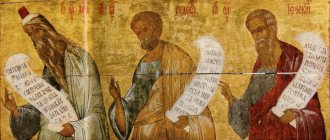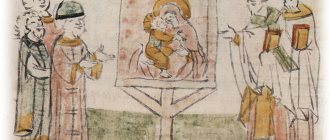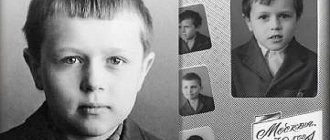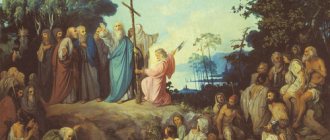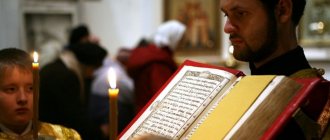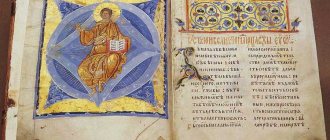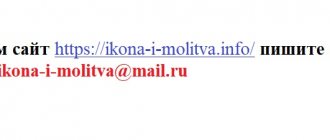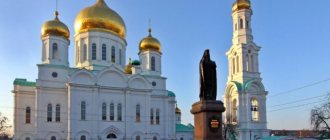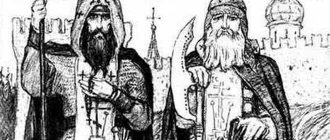The Orthodox Church is based on the Bible, which was originally written in several languages. Each word in the holy book has several meanings, the use of which results in a different perception of the meaning of what is written. There are several sciences that deal with the interpretation of messages and translation. Messages written by human hand according to the knowledge of God sometimes have a hidden meaning, which scientists and philologists try to reveal.
Andrei Sergeevich Desnitsky is a professor at the Russian Academy of Sciences, Doctor of Philology, and is engaged in Bible research, translations and publications on Christian topics. In addition to his main activity, he writes works of fiction, the first of which were published in 2000.
Andrey Desnitsky
What exactly does Andrey Desnitsky do?
The Bible is one of the most mysterious works written by human hand. It contains many hidden meanings that can be interpreted in different ways.
And the point is not only in words, but also in a large number of interpretations and translations of the sacred text of Christians.
The Russian Orthodox Church (hereinafter referred to as the ROC) is based on the Bible and revelations written and translated into ancient Greek, and subsequently into ancient Russian.
At the same time, a language, like a living being, is constantly changing and gradually some words disappear, while others completely lose their original meaning.
Andrey Desnitsky, bibliographer, Doctor of Sciences of the Russian Academy of Sciences
A whole layer of scientists - philologists - is engaged in the development of changes and the etymology of languages. They painstakingly study all possible changes in the etymology of words, and then, based on the information received, write their reports.
One of these scientists is Andrei Denetsky.
In addition to direct scientific activities, he publishes his own articles and works of art. Although the main range of his works is devoted to biblical topics.
views
In 1998, after the Appeal of Patriarch Alexy II to the clergy and parish councils of churches in Moscow at the Diocesan Assembly on December 16, 1997, Andrei Desnitsky spoke in defense of Fr. Vladimir Lapshin and Fr. Georgy Kochetkov and their right to publicly preach modernist ideas. The Patriarch, in particular, stated:
Priest Vladimir Lapshin agreed that there was repentance beyond the grave, but, on the contrary, there was no Entry into the Temple of the Most Holy Theotokos. His statement about the founder of Islam indicates complete theological illiteracy. Defending G.P. Yakunin and declaring his love for the defender of totalitarian sects, priest Vladimir Lapshin reproaches the Hierarchy for revenge, saying that they returned evil for evil. But is it evil to defrock an opponent of the Church? By telling his listeners lies about Patriarch Hermogenes, about monasticism, about the Lord Jesus Christ, Who is supposedly present in other religions, the unfortunate shepherd Vladimir Lapshin himself brings evil instead of good. Before the demonstration of the blasphemous film “The Last Temptation of Christ,” when the Hierarchy and the Orthodox people sharply condemned this step, the same priest Vladimir Lapshin called for watching the film, citing the fact that one cannot condemn what one has not seen, that is, sin can be condemned only after he has done it.
Andrei Desnitsky claims that these words of Fr. Lapshin are “taken out of context,” and if you write down every word of a person, take individual phrases out of context and interpret them accordingly, you can accuse anyone of heresy. Andrei Desnitsky objects to Patriarch Alexy: “I believe that Fr. Vladimir, as well as some other so-called. “Modernists” are looking for forms of church life that are fully consistent with the Orthodox faith and at the same time adequate to our time and our country.”
short biography
The overwhelming number of modern scientists and public figures were born in the Soviet Union and received their education in this country. Andrei Sergeevich Desnitsky, who was born in August 1968 (more precisely on the 21st), was no exception.
August 21, 1968
Andrey Desnitsky was born on this day
He was born into the family of the famous Soviet actor Sergei Desnitsky and philologist Svetlana Stepanovna Desnitskaya. Therefore, the childhood of the future bibliologist passed in an atmosphere of high culture and the desire for knowledge.
Which subsequently influenced the choice of profession.
Interesting fact: Andrei Desnitsky’s lectures regularly attract full audiences and are constantly posted on YouTube.
A. Desnitsky in the Yekaterinburg Yeltsin Center
However, young Andrei does not immediately enter the university to receive higher education. First, after graduating from high school in 1985, he went to serve in the Soviet army, subject to the law on compulsory military service.
After Desnitsky repaid his debt to his homeland, he goes in the footsteps of his mother to receive a philological education. Moreover, he enters the Faculty of Philology of Moscow State University.
1993
this year Andrey Desnitsky graduated from the University of Amsterdam
The training process lasted until 1992. Additionally, he devoted time from 1992 to 1993 to studying biblical translation at the Free University of Amsterdam.
After receiving a specialized education, he begins to work at the Institute of Oriental Studies of the Russian Academy of Sciences (Shel 1994). But one of the most global and significant events was the defense of a doctoral candidate at the Russian Academy of Sciences.
The topic of the dissertation was:
"The Translation Technique of the Septuagint in the Context of the Evolution of Hellenistic Poetics: An Analysis of the Songs and Blessings of the Pentateuch."
Since 1999, he has been helping at the Institute of Bible Translation to translate scripture tests into the languages of the fraternal peoples of the former USSR.
In 2010, he successfully defended himself for a doctorate degree from the Russian Academy of Sciences. Work theme:
"The Nature and Functions of Parallelism in Biblical Texts."
In addition to scientific activities, he continues to publish in various publications, Russian and foreign.
Andrey Desnitsky regularly writes interesting publications
organizations
For some time, Andrei Desnitsky was an employee of the Russian Bible Society. Consultant of the Russian branch of the Swedish ecumenical missionary organization “Bible Translation Institute” (since 1999).
Participant in the annual Bible readings in memory of Fr. Alexandra Menya, which are conducted by the Heritage College of Biblical Training for Ministries, the Society of Friends of the Holy Scriptures and the Library of Foreign Literature.
In 1999, 2000, 2002 and 2003. took part in the “St. Andrew’s Readings” organized by the Biblical-Theological Institute. He gave lectures at the Kiev Summer Theological Institute, i.e. in the summer lecture hall of the BBI.
Lecturer at the School of Youth Ministry of the Center for the Spiritual Development of Children and Youth.
He taught a special course at PSTGU “Introduction to modern biblical exegesis” (2011 - 2012)[1].
Participant in the “Swamp protests” 2011 - 2012[2]
Family
| Sergei Glebovich Desnitsky (1941 - ...) | Father, actor, works at the Moscow Art Theater |
| Svetlana Stepanova Desnitskaya (1940 - 2009) | Mother, a philologist, taught Russian. Recently I worked at TASS (edited photo chronicles) |
| Asya Stein | Wife. The wedding took place in 1986. Works as a teacher of world literature |
| Anna Sergeevna Desnitskaya (1987) | Daughter. Higher education - University printing in the field of “book graphics”. Works as a book illustrator |
| Daria S. Desnitskaya (1991) | Daughter. She followed in her grandfather’s footsteps and entered the Shepkinsky Theater School. Actress |
Adventures of the Bible in Russia
Books have their own destinies (habent sua fata libelli) - the ancients already knew this. But when these fates are discussed, they usually talk about how the book was written, edited, and published. Volumes have been written about the creation of the Bible; we will touch on this issue in chapter 19.
But when the book has finally taken shape as a single text, this is not the end, but rather the beginning of its story. And it reflects the life of peoples, societies and states where this book is published, read, translated - or they do not read and do not translate, or they do it secretly, or they first translate and then burn the translation...
This is the history of the Bible in Russia. The history of our Christianity, our bookishness, our culture and even - where can we get away from it - our internal politics. And at the same time our relationship with the rest of the Christian world and with ourselves. The adventures of the Bible in Russia are before you!
Pop Ghoul Dashing
This name is the first that is reliably known in the history of the Bible in Rus'. And this is not a fictional character of anti-clerical lampoons, he signed himself that way. Also, more precisely, he signed in Old Russian: “Az pop Oupir Lihyi.” Obviously, this was his worldly name along with his nickname. It is quite possible that he came from Sweden, where the name of the carver Upir Ofeigr, Upir the Untimid, is found on rune stones. Maybe this is how this name was translated into the language of our ancestors - Dashing Ghoul?
In any case, the Ghoul lived in Novgorod in the 11th century. and he was not only a priest, but also a copyist of biblical books, or rather, he was engaged in recoding them from Cyrillic to... Cyrillic.
I hope I have already confused and intrigued the reader enough to begin to unravel this tangle.
How does an ordinary person imagine the origin of the Church Slavonic Bible? Well, something like this: Saints Cyril and Methodius, the first Slavic scribes, came up with our alphabet, and then they took and translated the Bible into their language, and since then we have it. Only such a statement will be incorrect in literally every word.
Firstly, the brothers' names were Constantine and Methodius, the eldest of them took the name Cyril when he was tonsured into the schema on the eve of his death. The brothers themselves were not Slavs, but Byzantine Greeks and came from Thessaloniki, where there were many Slavs and everyone knew the Slavic dialect of the ancestors of today's Bulgarians - their descendants call that language “Old Bulgarian,” and not without reason.
Our ancestors even then spoke a slightly different language, which today is commonly called Old Russian. They said: “city dweller, volost, one,” and in the Balkans they said: “citizen, power, one.” The Russian language, as is easy to see, often included both words, and with different meanings. Typically, Church Slavonicisms (the Balkan version) had a more solemn meaning, and, as Slavists noted long ago, the slogan “Long live Soviet power” consists entirely of them. In the language of our ancestors, Old Russian, we wished not the authorities to be healthy, but the volost to be healthy.
The grammar also differed somewhat: for example, the form “dashing” is Russian, northern, but “dashing” is Balkan, southern. Why did the Novgorodian (and possibly Varangian) Upyr subscribe to the Balkan way? Yes, because he was a bookworm. It was Old Church Slavonic with its Bulgarian forms that remained the book language for a long time. Until now, the language coexists with the solemn “great” (-y in the southern manner) and the everyday “big” (-oi in the northern). Even with M.V. Lomonosov, these differences in the endings of adjectives served as a sign of high or low “calm”.
Further, Constantine-Cyril and Methodius did not translate the entire Bible into Slavic. They began work with the Gospel texts, which were read during the liturgy, then added to them other passages necessary for worship, because they did not need to print books, but to begin worship in the natural language of the Slavs. Even during their lifetime, they were helped by “cursive priests,” as their lives call them, and the work undoubtedly continued after their death - too much had to be translated, and some of what had already been translated had to be corrected by the “cursive writers.” Obviously, the Ghoul was one of those who did this.
Yes, but what about transcoding? As he himself noted, he copied books “is kourilovitsa,” that is, from the Cyrillic alphabet. What other encoding? Yes, also in Cyrillic. But KOI-8 or Windows-1251 have absolutely nothing to do with it. Cyrillic, as you might guess, was the name given to the alphabet originally created by Constantine-Cyril and Methodius. And it has nothing to do with the alphabet we write with today.
Currently, scientists agree that the invention of the Thessaloniki brothers was the alphabet, called the Glagolitic alphabet - tourists visiting Croatia find souvenirs with Glagolitic inscriptions there in abundance, especially since Glagolitic books were used for worship until recently on the Croatian island of Krk. Like the creators of the Georgian and Armenian alphabets, the Solun brothers came up with completely new letter styles, consisting mainly of circles, broken lines and triangles. Now only specialists can read them.
Where did the alphabet that we call Cyrillic come from today? It is not known exactly, but it is clear why it was invented. Why invent new letters when there were already enough of them in existing alphabets? Slavic books were translated from Greek, so it was quite natural to take the Greek alphabet for them, adding special letters to convey sounds that existed only among the Slavs. Two letters were borrowed from the Jews altogether: these are Ш (cf. ש) and C (cf. צ). So the Ghoul rewrote manuscripts in the Glagolitic alphabet in a new way.
There remains the last mystery about the Dashing Ghoul. If he really is the Swedish rune-carver Upir Nerobkiy, why in Novgorod did he not serve in the princely squad, like all decent Varangians, but was engaged in the book business? Of course, his biography is not open to us, but we still have one guess...
It is not known whether the Slavs had writing before Constantine-Cyril and Methodius. In various sources there are references to some kind of sign systems, for example, in the 10th century, the Bulgarian monk Khrabr reported that before the Slavs used certain “traits and cuts.” It was not necessarily an alphabet in our understanding, but rather a kind of system of conventional signs, for example, family marks that were used to mark livestock and other property.
But in the life of those same Constantine and Methodius it is said that even before the Slavic mission, Constantine found in Chersonese Tauride (present-day Sevastopol) “The Gospel and Psalter were written in Russian letters.” And this already means the presence of a full-fledged writing system on which you can create the most complex texts.
Yes, but what are “Russian letters”? In those days, Russia was mainly called the Varangians; a widespread hypothesis is that this word itself comes from the Old Norse root roþ-, meaning “to row with oars.” Perhaps this was the name given to the Viking detachments that sailed their ships along the rivers in the Slavic lands. Whether this is true or not, we don’t know, but suddenly... we are really talking about some Scandinavian letters that were also used by the Slavs? By that time, Scandinavia had long had its own runic writing, the Varangians communicated closely with the Slavs, and one of them - for example, the same Upir Nerobkiy - could well have settled in Novgorod to do his main job: rewriting texts. I gradually learned the Slavic language and its two alphabet...
Unfortunately, all of this is pure speculation and we have no way to verify it with the current data.
Yes, but how do we even know about the priest Ghoul Dashing? From a small postscript he made at the end of his own manuscript with Old Testament prophecies: “Glory to you, Lord and King of heaven, for you have made me worthy to write the books of Kourilovich Prince Vlodimir of Novgorod, the princely son of Yaroslavl the Greater. I started writing in the summer of 6555 on the month of May 14. And at the end of the same summer on the month of December on the 19th. I also pray to everyone to read this prophecy. Great are the miracles these prophecies have written for us in these books. May the prince live in good health forever, but do not forget whoever wrote.” The dating from the creation of the world corresponds to 1047 according to our chronology.
Interestingly, the manuscript of the Ghoul itself has not reached us, as often happens with ancient manuscripts; his name simply remained in manuscripts of a later time. But we really haven’t forgotten the writer, as the ancient Russian scribe priest Vupyr Likhoy asked.
Public activities
During his entire work, the philologist wrote more than fifty articles on various biblical and near-biblical topics. Books by Andrei Desnitsky telling about the Old Testament are especially popular.
These works are regularly published in print and occupy bestseller shelves in specialized stores.
Articles by Andrei Desnitsky are published on websites and subscription magazines and often concern a wide variety of aspects of biblical topics. Although this mainly concerns the areas of correct translation of texts.
Video lectures by Andrey Desnitsky
Speeches by Andrei Sergeevich at the Yeltsin Center.
By leaving a comment, you accept the user agreement
essays
- The Septuagint as a literary translation // The Bible: literary and linguistic studies. Vol. 3 / Rep. ed. S.V. Lezov, rep. ed. S.V. Tishchenko. M.: RSUH, 1999
- Biblical parallelism, ancient rhetoric and antinomian theology // First Biblical readings in memory of Fr. Alexandra Menya (September 10-11, 2004, Moscow)
- Is “Orthodox biblical studies” possible? // Second Bible readings in memory of Fr. Alexandra Menya (January 25-26, 2006, Moscow)
- Scripture. Tradition. Modernity. K.: Quo vadis, 2006
- Notes from Balabol. K.: Quo vadis, Publishing House Nadezhda, 2007
- The poetics of biblical parallelism. M.: Biblical and Theological Institute of St. Apostle Andrew, 2007
- The Bible and the Orthodox tradition. M.: EKSMO, 2008
- People and Phrases (2011)
- Introduction to Biblical Exegesis (2001)
- Desnitsky A. S.
What does the Bible say about the physical side of love? // Two into one flesh. Love, sex and religion / with the support of the Tradition Foundation. - M.: Eksmo, 2011. - 253 p. - (Books of Life). — ISBN 978-5-699-48434-8.
articles
- Review of the book by B.M. Metzger “Textology of the New Testament: Manuscript tradition, the emergence of distortions and reconstruction of the original” // Pages. 1996. No. 3
- The Old Testament canon in the Orthodox tradition // Pages. 1996. No. 4
- Is the Book of Jonah an Old Fairy Tale? // World of the Bible. 1997. No. 4
- Conference on Biblical Studies (Moscow, September 28-30, 1997) // Pages. 1997. No. 2
- Textual basis of the Synodal translation: (Old Testament) (report at the International Conference “Russian Translations of the Holy Scriptures”. Moscow, June 10-14, 1996) // Pages. 1998. No. 3
- Has the original Bible reached us? // Foma. - 2006. - No. 10(42).
- Which translation is correct? // Foma. 2007. No. 1(45).
- Why do they make sacrifices? // Foma. 2007. No. 4(48).
- The doors of hell are locked from the inside // Thomas. 2007. No. 4(48).
- Does Orthodox mean Russian? // Foma. 2007. No. 6(50).
- Why do the Orthodox “not have everything according to the Bible”? // Foma. 2008. No. 2(58).
- What is “Inspiration” // Thomas. 2008. No. 9(65).
- “Vengeful” Psalter // Thomas. 2010. No. 3(83).
- A few words in defense of God from theologians
- Linguists about evolution // Internet publication “Tatyana’s Day”. March 2, 2010
translations
- St. Gregory of Nyssa, On the life of Moses the Lawgiver. M.: Temple of Cosmas and Damian on Maroseyka, 1999
- Proverbs. Book of Ecclesiastes. Book of Job: Proverbs / Trans. and comm. A. S. Desnitsky, E. B. Rashkovsky and E. B. Smagina. Book of Ecclesiastes. Per. and comm. A. E. Grafova. Book of Job. Transl., comm., and textual critic., approx. A. S. Desnitsky. M., Russian Bible Society, 2000.
- archim. Cyprian (Kern). Eucharist (from readings at the Orthodox Theological Institute in Paris). M.: Temple of Cosmas and Damian on Maroseyka, 2006 (translation of quotes by A.S. Desnitsky)
